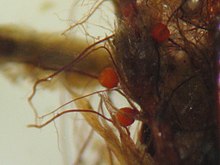Rhizoid

Rhizoids are single or multicellular root-replacing hair formations of the thallophytes . They occur in highly developed algae , fungi and mosses , and also in the gametophyte of fern-like plants . In the case of algae, they primarily serve to anchor them to the subsurface (e.g. soil , wood and bark, rock, mussel shells or large algae). Rhizoids are usually more simply structured than roots and do not contain any specialized conductive tissue.
Among the algae, chandelier algae and many brown algae have rhizoids. In the laminariales , which belong to the brown algae , these adhesive organs are often coarse, multicellular and highly differentiated.
In deciduous mosses , the rhizoids consist of filaments of single cells, in hepatica and hornwort from long, tubular (tubular) single strands.
Rhizoids are also found in some rootless seed plants , such as water hoses .
Individual evidence
- ^ A b Neil A. Campbell, Jane B. Reece: Biology. 8th edition, Pearson, Munich a. a., 2009, ISBN 978-3-8273-7287-1 , p. 1835 and p. 822.
- ^ Peter Sitte, Hubert Ziegler, Friedrich Ehrendorfer, Andreas Bresinsky: Strasburger, textbook of botany. Gustav Fischer, Stuttgart, Jena, New York 1991, ISBN 3-437-20447-5 , p. 234, p. 600, p. 613 and p. 647.
